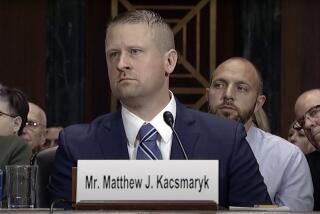Abortion Bill Reveals Fight for the Unconvinced
- Share via
KETTERING, Ohio — If a majority of lawmakers in Washington would get their way, the unassuming chalet-style building at the corner of East Stroup and Vineyard here would be a crime scene. It is there that Dr. Martin Haskell, one of a handful of doctors nationally who performs abortions on women more than five months’ pregnant, maintains his practice.
Abortion opponents, who last week won approval of a bill to outlaw the late-term abortions Haskell provides, call the procedure he uses “partial-birth abortion” because all but the head of the fetus is pulled out of the birth canal, in many cases still alive, before a tube is inserted into the skull to remove its brain tissue.
The medical establishment and defenders of abortion rights, including President Clinton, who is expected to veto the bill sometime this week, favor a more clinical term, “intact dilation and extraction,” to describe the procedure.
That contrast between the lurid and the clinical descriptions offers a revealing glimpse of how abortion foes are hoping to capture what they see as a major prize in the abortion debate: the morally uncertain middle.
By focusing on a particular kind of late-term abortion, and by describing it over and over in gruesome detail, abortion opponents believe that they may have captured the support of many Americans who do not usually associate themselves with the “right to life” movement.
While in Washington positions on abortion are often as sharp as a scalpel, a world away, in the modest middle-American neighborhoods that surround Haskell’s clinic, the battle lines are not so clear.
Here, citizens who proclaim themselves solidly in favor of abortion rights agree vigorously that there should be limits on late-term abortions. Others who see themselves as opponents of abortion take pains to offer exceptions for rape, incest and a mother’s health.
David Ruppert, 46, who lives three blocks from Haskell’s clinic, said that “no one can understand the predicament a woman is in, and I have no place” denying a woman the choice to end a pregnancy. Yet asked about the late-term abortions Haskell performs, Ruppert gave a look of acute discomfort and said that “there’d have to be fairly strong circumstances surrounding it.”
Ruppert is part of the huge middle ground in the abortion debate--a moral no-man’s land occupied, by some estimates, by more than 50% of Americans. Abortion rights advocates, who argue that women should have a right to choose, traditionally have won the allegiance of many on this uncertain turf. But as the recent dispute demonstrated, abortion foes see this middle ground as a prime source of converts.
*
Two days after the House voted, 286 to 129, to outlaw “partial-birth abortions,” Haskell’s office in Kettering was quiet. A guard in a bulletproof vest warily eyed visitors, and a single antiabortion protester, armed with grisly photographs, maintained a quiet vigil outside. Neither Haskell nor any of his staff would agree to be interviewed for this story.
In surrounding neighborhoods, many people who were asked about their views on abortion conveyed a sense of deep ambivalence and a distaste for the polarized national debate over the matter. They seek some middle ground--and many see it in the bill just passed by Congress.
“Absolutely, it strikes me as contradictory,” conceded Ken Jones, a 45-year-old banker from Dayton, Ohio, who was running errands a few blocks from Haskell’s clinic. “That I can justify ending a pregnancy at one month but not at seven? But we live in an ambiguous world. And there are a lot of people ambiguous about abortion, a lot of people in this middle ground.”
Mark Egloff, a 42-year-old procurement specialist from Kettering, wears a label, “pro-life,” that sets him in irreconcilable opposition to Jones. But he shares with Jones a sense of moral ambiguity within his position, which would allow abortion in cases of rape, incest or to protect a mother’s health. And he also shares Jones’ frustration with the black-and-white abortion debate that usually takes place in Washington.
“There is no middle ground allowed,” Egloff said. “Any time you try to find a middle, there’s finger-pointing.”
Indeed, while support for a woman’s right to abortion traditionally runs at about 50% and opposition at about 35%, some recent polls reveal the finer shades to many Americans’ beliefs.
A February poll conducted by CBS News and the New York Times found that 36% of Americans believe abortion should be available with no stated restrictions, and 7% said it should not be permitted at all. Between those extremes, however, 22% said abortion should be available with stricter limits, and 34% said it should be illegal except for cases of rape, incest or to save a mother’s life.
*
The Supreme Court, in its 1973 Roe vs. Wade decision, left to states the right to limit abortions after the second trimester of pregnancy--the point at which specialists generally agree that a fetus could survive outside the womb, given expert medical intervention. Currently, 41 states, including Ohio, have adopted restrictions on such late-term abortions.
But to the consternation of abortion foes, almost all contain broad exemptions for cases where the mother’s health, including her emotional health, is endangered. Under the new legislation, “partial-birth abortions” can be performed only to save a mother’s life.
With support in the Senate not large enough to override a veto, the victory almost certainly will be short-lived. And since the procedure represents only about 500 of the 1.5 million abortions yearly, its effect is extremely limited.
But with their “partial-birth abortion bill,” antiabortion forces make clear they hope to accomplish a broader and more subtle goal than saving 500 unborn children: They hope to capitalize on the discomfort that many in this middle ground have with late-term abortions and with abortions generally.
By citing the advanced stage of fetal development and by focusing, in gruesome detail, on one such procedure, they believe that they can pry some people from their position in favor of abortion rights.
“The goal of everything we’re doing is to get people to see that abortion is horrible when done at 24 weeks of gestation. But it’s also horrible when done at 16 weeks or at eight weeks,” said Patricia Kuivenen, executive director of the Right to Life chapter in Dayton. “If you can convince people that it’s bad at 20 weeks, it’s not such a big step to get them to understand that it’s bad at 16 weeks or at 12 weeks.”
Rep. Enid Waldholtz (R-Utah), a staunch anti-abortion lawmaker who managed much of last week’s debate on the House floor, was more subtle. “I would hope that this particular bill is an area where we can find that elusive common ground and prohibit a procedure that partially delivers a live child before killing it and completing the procedure,” Waldholtz said.
*
Defenders of abortion rights, however, contend that late-term abortions are not the wedge issue that antiabortion activists hope. While their claim is impossible to confirm, opponents of the bill argue that late-term abortions are performed mainly on women who have learned of a devastating defect in the fetus or on women suddenly stricken by diseases that make pregnancy dangerous to their health.
They scoff at the suggestion that abortion foes have won a lasting victory with their latest effort or would be content to stop at limiting late-term abortions.
“The dirty little secret these lawmakers don’t want to talk about is that these are wanted pregnancies that have gone tragically awry,” said James Wagoner, vice president of the National Abortion and Reproductive Rights Action League.
In Kettering, it is clear that those in the middle on abortion are repelled by the gruesome images brandished by antiabortion activists. But few are more drawn to their cause as a result.
“I don’t see that as getting rid of the polarization,” said Egloff of the protests outside Haskell’s clinic. With a sigh, he said he steers a wide berth around the clinic whenever possible. “I think it just contributes to it.”
More to Read
Get the L.A. Times Politics newsletter
Deeply reported insights into legislation, politics and policy from Sacramento, Washington and beyond. In your inbox three times per week.
You may occasionally receive promotional content from the Los Angeles Times.











